DVSA digital, data and technology strategy, 2018 to 2020
Published 23 April 2018
Applies to England, Scotland and Wales
Foreword

The Driver and Vehicle Standards Agency (DVSA) is working every day to help you stay safe on Great Britain’s roads.
Our digital, data and technology infrastructure is a vital part of helping you stay safe. Without it, you couldn’t book a driving test or have your MOT result recorded, and we couldn’t target unsafe drivers and vehicles at the roadside.
We’ve made a lot of progress in recent years. However, there’s still a lot more we can do to provide better services and better value for money, and make a real difference to road safety.
So I’m really pleased to introduce our digital, data and technology strategy. It sets out the direction for our digitally-enabled organisation. It covers how we work, what we’ll do for you, and what we need to succeed.
It tells you about our ambition to transform the way we work, help our staff work more efficiently, and provide world-class digital services.
Doing this will be exciting and challenging. We’ll need to continue developing the right skills and culture among our people and leaders to succeed.
DVSA’s vision is for safer drivers, safer vehicles and safer journeys for all. I’m really excited about applying the culture, practices, processes and technologies of the internet era to make that vision a reality.
James Munson
Director of Digital Services and Technology
1. Introduction
We published the DVSA strategy for 2017 to 2022 in March 2017. It sets out what we’ll do to help you stay safe on Great Britain’s roads.
Our digital, data and technology infrastructure is essential for the strategy to be successful.
This digital, data and technology strategy tells you what we’ll do between 2018 and 2020 to provide modern, efficient and sustainable technology to support a mobile workforce and build brilliant digital services for users.
The strategy is about:
- transforming our driver, vehicle and enforcement services
- enabling mobile working, working together and intelligence and data sharing
- delivering improved digital services and technology
- the things we depend on to achieve our digital, data and technology objectives
- how our work supports government policy
2. Our digital, data and technology objectives
At DVSA, our digital, data and technology objectives are split into 3 main areas:
- transform - which is about creating and running more great digital services for drivers, vehicles and enforcement
- enable - which is about improving the way our people work through better digital services, technology and intelligence and data sharing
- deliver - which is about delivering end-to-end services, backed up by plans, principles and the right technology
2.1 Transform

Our aim
We’ll create and run more great digital services for drivers, vehicles and enforcement, which will help you stay safe on Britain’s roads.
Driver and rider services
We’ll transform services for drivers and riders to help you through a lifetime of safe driving.
We’ll do this by making information available to learner drivers, improving practical test availability and modernising theory testing.
We’ll deliver:
- information to help learner drivers prepare for their theory and driving tests, including giving learner drivers more information about driving instructors, so they can make more informed decisions on who to choose
- digital services to support the theory test, giving customers better ways of using the service, including exploring the possibility of using technology to allow learner drivers to take their theory test at a time and place that suits them
- transformed services for driving tests and motorcycle tests, including allowing our driving examiners to record test results directly onto a tablet, rather than on paper
- expertise to support you through a lifetime of safe driving, for example, by keeping theory and driving tests up to date with vehicle and technology changes, making it easy for you to have the knowledge and skills you need throughout your driving life
Vehicle testing services
We’ll transform vehicle testing services to help you keep your vehicle safe to drive.
We’ll do this by continually improving the MOT digital service and introducing new digital commercial vehicle testing services.
We‘ll deliver:
- continuing improvement to our MOT services, including launching a digital service to set up an MOT garage, and improving our testing software, based on garage and tester feedback
- improved commercial vehicle services, including a new digital service to record lorry, bus and coach annual test results, and services for authorised testing facilities to manage their business with us
Enforcement and compliance services
We’ll transform enforcement and compliance services to protect you from unsafe drivers and vehicles.
We’ll do this by continuing to improve the vehicle operator licencing service, improving roadside checks and supporting the Strategic Traffic Management and Remote Enforcement Offices.
We’ll deliver:
- continuing improvements to the services to apply for and manage vehicle operator licences, based on user feedback, so operators can manage all parts of their licence online.
- digital services so vehicle operators can share information with us about their vehicles’ compliance and join our earned recognition scheme as it develops - this is a new way for operators to prove they meet driver and vehicle standards
- improvements to digital tachographs, which will help to prevent tampering
- better technology to support strategic traffic management and remote enforcement - the parts of DVSA which gather and act on information about non-compliant drivers and vehicles
- improvements to mobile and static cameras and equipment, and better communications at the roadside
- digital services to make it easier to record when vehicles have been found unsafe at the roadside and to fine the drivers and operators on the spot, using a digital payment service
- changes to our services to support the introduction of the new EU Roadworthiness directive, which will change things like the way vehicle defects are categorised at MOTs from May 2018
2.2 Enable
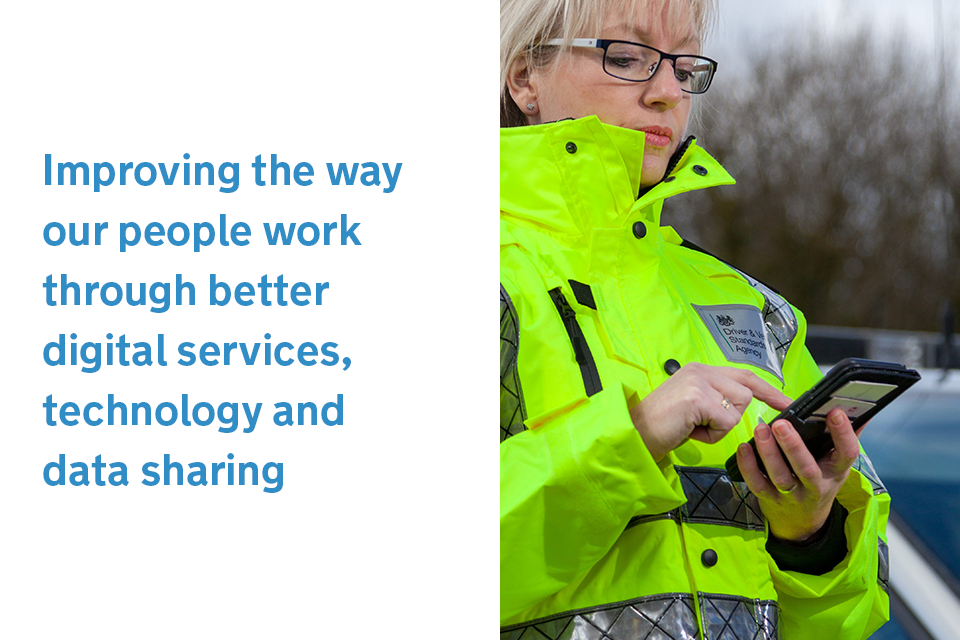
Our aim
We’ll improve the way our people work through improved digital services, technology and intelligence and data sharing, which will help you stay safe on Britain’s roads.
Mobile working
Mobile working is vital to our work. Our driving examiners, vehicle standards assessors and traffic examiners work right across Great Britain in our own buildings, partner premises or even at the roadside.
We’ll make sure they have reliable devices and tools that can access our services whenever and wherever they need them.
We’ll deliver:
- apps and services that are designed to run on DVSA mobile devices, for example, to record driving test results
- reliable connectivity
- improved workforce management, which will allow us to hire the right people, at the right place and time, and with the skills to deliver our services
Working together
As our staff are spread across Great Britain, it’s especially important that we have the technology to be able to work together.
We also need to be able to work with our suppliers and other Department for Transport (DfT) agencies.
We’ll:
- make it easier for our staff to work together and be more productive, for example, through the use of Microsoft Office apps, providing Surface Hubs (interactive, multi-user touch screens) and smartphones, and developing job-specific apps and services
- have digital services and technology business partners in place, who can build trust with other teams in DVSA and with external partners, which will help us prioritise and deliver the right projects and services
- continue to use shared finance and HR services across DfT
Sharing data
We need high-quality data to make decisions and measure whether we’ve achieved our goals. We have to be transparent, but we have to balance that with protecting sensitive information.
Bearing this in mind, we’ll share relevant information across DVSA, and with our users, industry and other government departments.
We’ll:
- invest in self-service analytics and data science capabilities, so our people can access and work with data, even if they don’t have a background in statistical analysis
- give our staff access to data that will enable smarter enforcement and better decision-making
- get and give access to up-to-date and accurate data that we need or hold, using government registers (lists of government information)
2.3 Deliver

Our aim
We’ll deliver end-to-end services, backed up by plans, principles and the right technology, which will help you stay safe on Britain’s roads.
Efficient and reliable capabilities
We’ll make sure our people have more reliable laptops, PCs and mobile devices and get the right technical support when they need it.
We’ll reuse, rent, buy or build services to get the best value for money. And we’ll use the Government Digital Service (GDS) Common Technology Services - with cheaper, cloud-based solutions and shared technology components. This will help our people to work more flexibly and efficiently, whilst maintaining consistent standards across government.
We’ll deliver:
- modern technology, including a digital phone system, smaller laptops and mobile devices
- a service catalogue, from which our people can select the goods and services they need, and then make sure they get them when they need them
- continuous improvement to support our services throughout their useful life
Plans and principles
Clearly defined plans and principles will guide us as we set about making significant changes.
We’ll develop:
- a set of principles to guide the way we work
- architectural methods, standards and governance - this means drawing up IT blueprints, making sure the structure meets user needs, overseeing delivery and controlling the quality of the operational service
- a target architecture, which sets out our technology aspirations - this will support change by speeding up the delivery of projects, while managing risks, and making sure that our digital and technology assets deliver the best value and meet our future needs
- a data strategy to set out how we’ll gather more useful data, and use that data to make well-informed decisions - we’ll do this in compliance with the General Data Protection Regulation (GDPR), which strengthens and unifies data protection legislation
- a set of government common technology services - some of which will be specific to DVSA - for maximum benefit, for example, using GOV.UK Notify (which enables government to communicate with users by text, email and letters) and GovWifi (which allows staff and visitors in government organisations to connect and stay connected to a secure wifi service whilst they move from building to building)
Using the agile approach
We’ll use the agile approach to build and run our services. This means we’ll build quickly, test what we’ve built and iterate our work based on regular feedback. This will let us keep our service current when policy changes and technology develops.
We’ll:
- deliver projects at the right time, in the right order, and meet our required business outcomes by having the right processes and governance in place
- put an end-to-end service delivery model in place, managed by skilled people who can prioritise any improvements the services need
- effectively manage our technology vendors (the organisations who supply to us), and create a sourcing and capability plan to give us better value for money and better control of our vendors
2.4 How we’ll measure the success of the strategy
Our strategy will improve road safety, user experience and value for money.
We’ll measure success for each service, including:
- digital take-up
- user satisfaction
- completion rate for transactions
- cost per transaction
We’ll also measure things like:
- staff satisfaction with having the right tools for the job, as measured in the Civil Service people survey
- staff in our Digital Services and Technology directorate understanding how their work contributes to DVSA’s aims
- improved efficiency
- whether the expected benefits of new or improved services are achieved
3. What we’ll do for our users
Service design starts with identifying user needs. If you don’t know what the user needs are, you won’t build the right thing.
We’ll research, analyse data, and talk to users. We won’t make assumptions. We’ll have empathy for users, and remember that what they ask for isn’t always what they need.
We’ve split out what we’ll do to:
- help you through a lifetime of safe driving
- help you keep your vehicle safe to drive
- protect you from unsafe drivers and vehicles
- make DVSA a great place to work
In each section, we show what we’ll do for different types of example users (called ‘personas’). They don’t show every type of user we serve, but they cover some of the main groups.
These aren’t real people, but they help us to understand how people interact with our services.
3.1 Helping you through a lifetime of safe driving
Learner driver
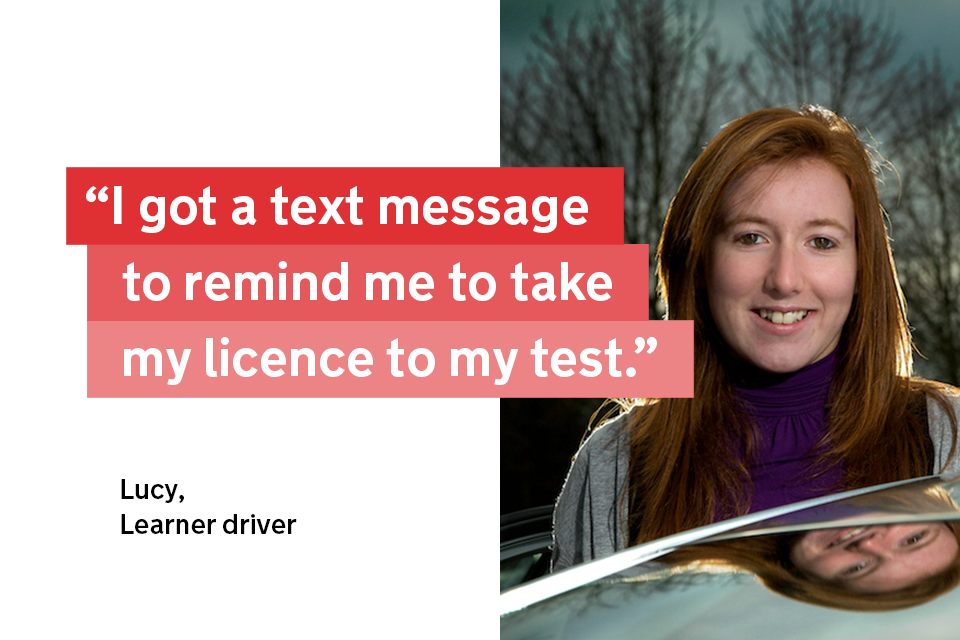
Lucy, a learner driver
Lucy is 20 years old and wants to learn to drive. She works full-time in a supermarket.
Lucy lives with her parents, where she has access to a PC. She also uses a smartphone, mainly for social media like Facebook and Snapchat, other messaging apps like WhatsApp, and watching videos.
She doesn’t have a credit card, and is used to paying for most things by contactless payment using her phone, or using PayPal when shopping online.
To help people like Lucy, we will:
- make sure it’s easy to understand the end-to-end journey of learning to drive, what you need to do, and in what order
- improve our service to find driving schools, lessons and instructors, so it’s easier to find the best driving instructor for your needs and book lessons with them
- provide and continuously improve high-quality learning materials, like the official DVSA theory test app, to help you prepare for the theory test - we’ll also allow other publishers to license our content to make their own materials
- develop an online driver’s record, so you can record your progress learning to drive with your driving instructor, and keep a track of private practice you do
- improve our theory test and driving test booking services, so it’s easier to find an appointment that suits you and your driving instructor, book and pay for your test conveniently and securely, and then change your appointment if you need to
- remind you about your test appointment time and what to bring with you, using platforms like GOV.UK Notify so you get text message or email reminders
- use social media to make it easy for you to get information and advice about driving and the tests, such as The Highway Code on Twitter, or the DVSA YouTube channel
Driver

Anil, an experienced driver
Anil is 25 years old and passed his driving test when he was 17. He hasn’t looked at The Highway Code since then. He works full-time and drives the 7-mile journey to work every day.
Anil spends a lot of time using his smartphone - mainly for Facebook, Instagram and WhatsApp, and watching videos on YouTube.
He’s already looking forward to getting his next car, and he likes the idea of having more gadgets, like virtual assistants to play music while driving, or getting directions from his phone’s map app being paired with his car.
To help people like Anil, we will:
- make sure our information about changes to driving laws and rules are easy to find online, and that they’re easy to understand
- make sure it’s easy to find official guidance about using new vehicle technologies safely, for example, vehicles that can pilot themselves on motorways with human oversight
- continue improving our official Highway Code app by carrying out user research and understanding how we can take advantage of new mobile technologies to make the content more engaging and easier to understand
- explore how we can partner with MOT centres to use digital display screens in their receptions and waiting areas, which we’ll use to share safe driving advice and encourage further training
- work with other organisations to make it easy for you to keep your knowledge and skills up to date for the rest of your driving life
- use social media to make it easy for you to get information and advice about driving safely, such as The Highway Code on Facebook, or the DVSA YouTube channel
Driving instructor
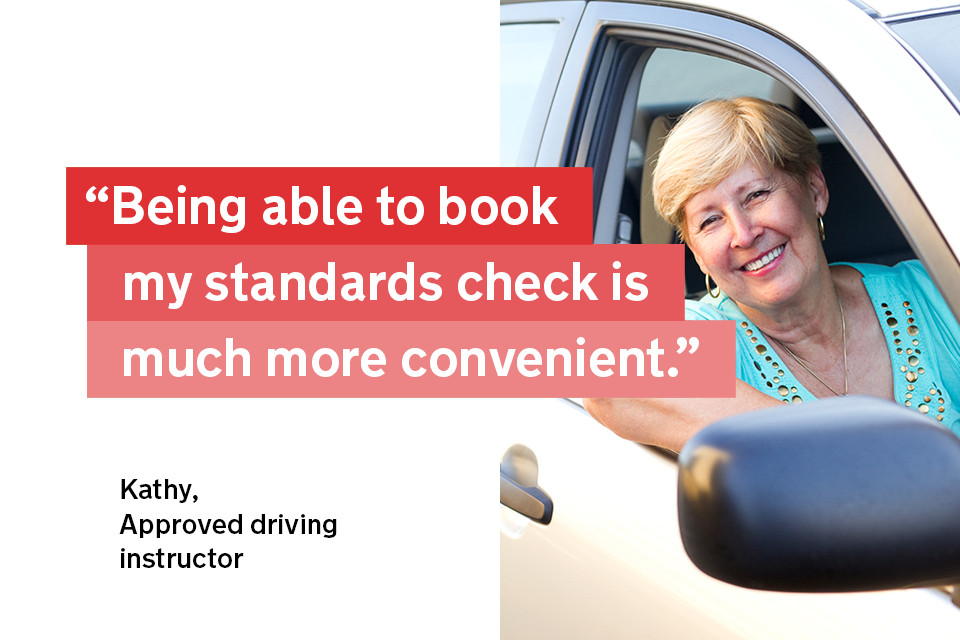
Kathy, an approved driving instructor (ADI)
Kathy is 57 years old and has been an ADI for 13 years. She runs her own driving school.
Kathy spends most of her time in the car giving driving lessons or driving to her pupils to pick them up for their lessons. She has a mobile phone with her, which she uses when she’s not driving or instructing to manage her business.
She books driving tests on behalf of her pupils so she can manage her diary effectively. This is important to her as she also provides care for her elderly mum, and she needs to keep her diary clear at certain times to do this.
To help people like Kathy, we will:
- make sure it’s easy to understand the end-to-end journey of becoming a driving instructor, what you need to do, and in what order
- improve our digital services to apply to become a driving instructor, get a trainee driving instructor licence, book and manage the tests you need to take to qualify, and then register when you’ve successfully qualified
- make it easier to update and manage your ADI registration once you’re qualified, including being able to record that you follow the ADI code of practice and your commitment to continuing professional development - and then choose what information you want to make available to learner drivers looking for a driving instructor
- improve our digital services to renew your ADI registration every 4 years, and look at ways of using platforms like GOV.UK Notify to send you text or email reminders when it’s time to renew
- introduce a digital service so you can book your ADI standards check at a time that’s convenient to you
- make it easier to book and manage driving tests for your pupils from your mobile phone, and pay for tests conveniently and securely
- make it easier to access and use the national standard for driving, the national standard for driver and rider training, and the learning to drive syllabus
- make it easy for you to give feedback about the services you use, so we can be sure we’re making the right changes to improve them
- share information about what we’re doing to improve the services on our Despatch blog for driver and rider trainers and send you email alerts about these blog posts - this will help you know what’s changing and why
- share information about changes to laws, rules and policies that affect you as a driving instructor using the Despatch blog, email alerts and social media
3.2 Helping you keep your vehicle safe to drive
Driver
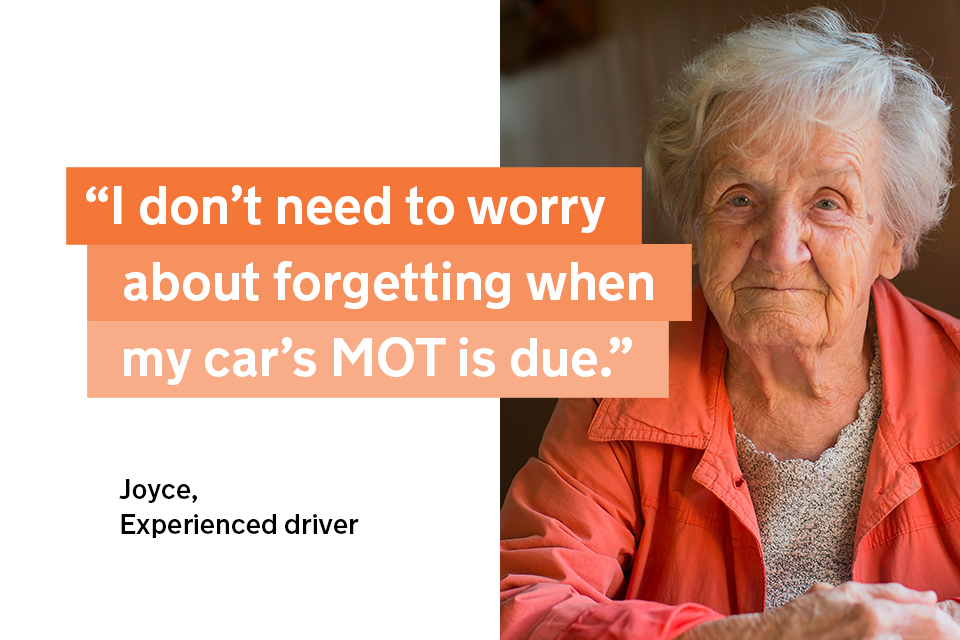
Joyce, an experienced driver
Joyce is 82 years old, retired and recently widowed.
Her husband used to look after everything to do with the car. Since her husband died, Joyce has been able to stay independent by driving, but she’s worried about how she’s going to cope.
Joyce doesn’t use the internet. She has a very basic mobile phone for calling and texting. However, Joyce’s children and grandchildren use the internet, and they research things for her and use services that can save her time and money.
To help people like Joyce, we will:
- provide help if you need to use our digital services, but don’t have the skills or access to do so on your own, for example, by providing support by phone to sign you up for MOT reminder text messages
- continue improving our service to get MOT reminders by text or email, so you don’t forget to get your vehicle tested, and don’t get reminders for a vehicle you no longer have
- update our service to check the MOT history of a vehicle so that it reflects the new types of faults that will be recorded at MOT tests from May 2018
- continue improving our services to view information about a vehicle by looking at other information that will help you, including that held by other organisations - for example, we’ve started to make it easier to check if a vehicle has an outstanding manufacturer safety recall
- use the data we hold about all MOT test results to make it easy for you to understand the reasons your make and model of vehicle might fail the MOT, and what you should do to keep it safe to drive all the time
- help you find and choose which MOT centre to use, based on official government information
- look into getting rid of the need for you to have a paper MOT certificate, which you have to pay to replace if you lose it
MOT centre manager
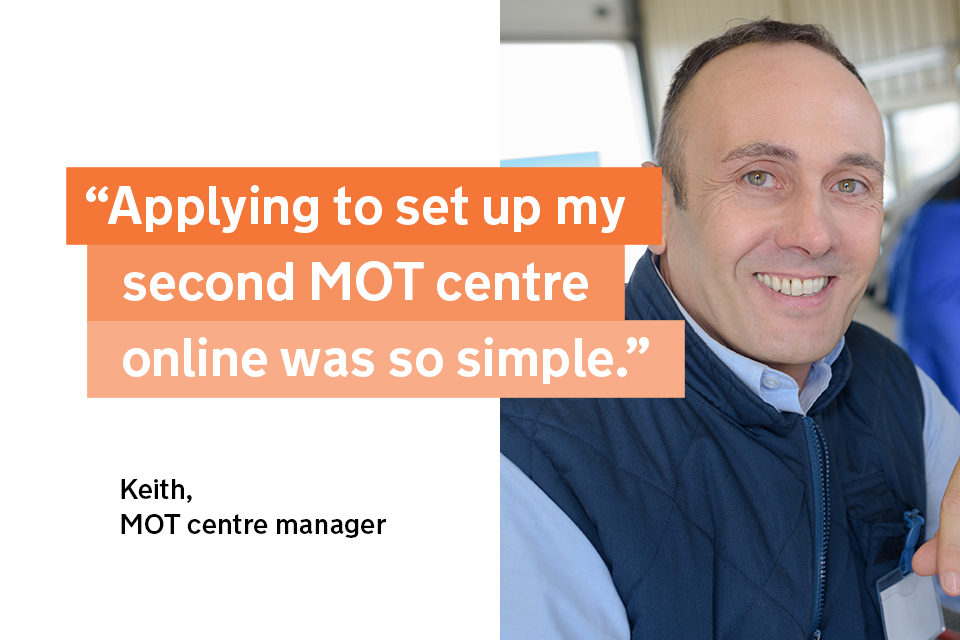
Keith, an MOT centre manager
Keith owns and runs a local MOT centre, and set it up 10 years ago after being an MOT tester himself.
Over the last 10 years, the business has built up a good reputation for quality, customer service and value for money. Keith is now thinking about opening up another MOT centre on the other side of the city.
He’s not looking forward to doing all the paperwork. Keith remembers there were lots of forms to fill in last time, and the guidance on how to do it wasn’t as useful as it could have been.
To help people like Keith, we will:
- make sure it’s easy to understand the end-to-end journey of setting up and running an MOT centre, what you need to do, and in what order
- create a digital service to apply to set up an MOT centre, making it easy to track the progress of your application and book an appointment for DVSA to inspect your premises
- continue improving the management reports in the MOT testing service, so you can easily see the performance of your MOT testers, and how your business compares to other MOT centres - this will help you make decisions about how to run your business, for example, where to target training among your testers
- work with larger MOT centres to provide them with bulk data about how they test, to help improve the quality of their testing and help to reduce fraud in the MOT scheme
- make it easy for you to give feedback about the services you use, so we can be sure we’re making the right changes to improve them
- share information about what we’re doing to improve the services on our Matters of Testing blog for the MOT industry and send you email alerts about these blog posts - this will help you know what’s changing and why
- share information about changes to laws, rules and policies that affect you as an MOT centre manager using the Matters of Testing blog, email alerts and social media
MOT tester
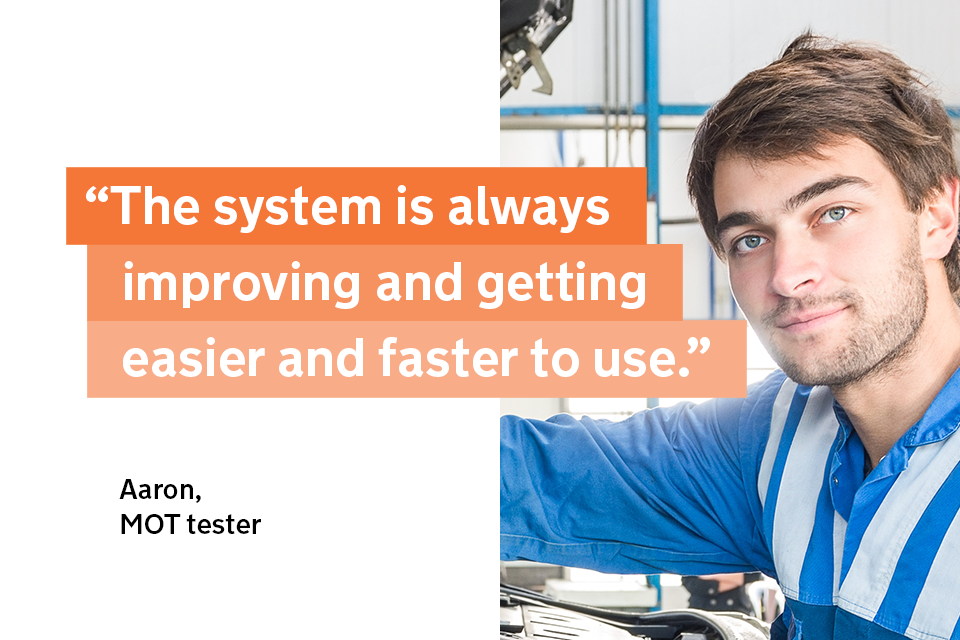
Aaron, an MOT tester
Aaron is 23 years old and was diagnosed with dyslexia when he was 12.
He’s been qualified as an MOT tester for 2 years at a local MOT centre. He also carries out servicing and repairs. This is the part of the job he enjoys the most, as carrying out MOT tests can be quite repetitive and involves more admin work.
Aaron wants his MOT centre manager to buy tablet computers. This will let him record MOT test results as he’s testing and look things up more easily when testing new types of technology in cars.
To help people like Aaron, we will:
- make sure it’s easy to understand the end-to-end journey of becoming an MOT tester, what you need to do, and in what order
- make sure it’s easy to find MOT tester qualification courses, set up your account in the MOT testing service and book an MOT demonstration test so you can start carrying out MOT tests
- continue improving the MOT testing service, so you can only select defects that relate to the vehicle you’re testing, making it quicker and more accurate
- work on letting you connect your MOT centre’s equipment and vehicles to the MOT testing service to directly capture results on things like emissions and brake tests, and look at fault codes and mileage
- look at ways to give you information about how to test more complex vehicles, like hybrid and electrically-powered vehicles
- make sure it’s easy to take your MOT tester annual training, study the right topics and book and take your annual assessment - and we’ll work to improve the service so your assessment results are automatically added to your profile, so you don’t need to do it manually
- make our services and content accessible by thinking about accessibility from the start
- make it easy for you to give feedback about the services you use, so we can be sure we’re making the right changes to improve them
- share information about what we’re doing to improve the services on our Matters of Testing blog for the MOT industry and send you email alerts about these blog posts - this will help you know what’s changing and why
- share information about changes to laws, rules and policies that affect you as an MOT tester using the Matters of Testing blog, email alerts and social media
Vehicle operator
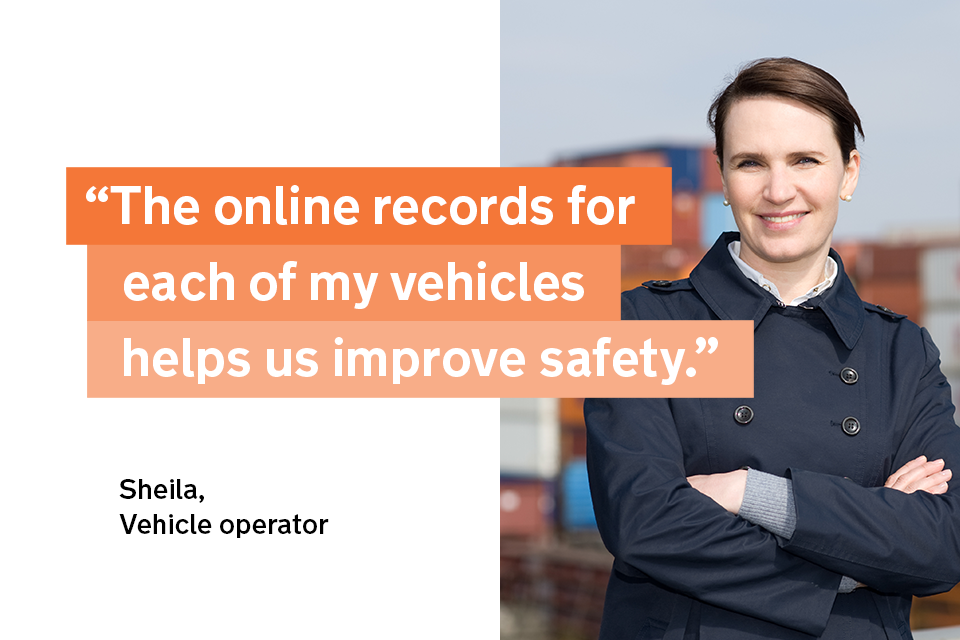
Sheila, a lorry operator
Sheila is a director in a nationwide haulage company that carries their own goods, and other people’s goods - both in the UK and on international journeys.
The company carries out its own servicing and maintenance. It has a thorough safety programme in place including things like driver walkaround checks, regular safety inspections, informal safety inspections and first-use inspections.
Sheila’s staff monitor safety inspection results, walkaround check results, annual test results, and the Operator Compliance Risk Score system to make sure the safety programme is effective.
To help people like Sheila, we will:
- improve our digital services so you can access information about your vehicle fleet, provide details on maintenance, see a history of your vehicles’ roadside encounters with DVSA and what happened as a result
- make sure our people can easily access your records at the roadside, so they can find information about your licensing status, your vehicles’ test history, your drivers, and up to date information about test performance - this will let you easily monitor your own performance, spot trends and deal with problems very quickly
- give you easy access to your vehicles’ annual test (MOT) histories - and open them up for others to see this information
- give you access to a single vehicle record, including vehicle-specific data, such as weights
- include the ability to access your vehicles’ electronic systems for difficult-to-test items in our new system - for example, emissions, electronic brakes systems and ‘AdBlue’ systems (AdBlue is a chemical that helps to reduce the harmful emissions produced by diesel engines)
- share information about what we’re doing to improve our services on our Moving On blog for the lorry, bus and coach industry and send you email alerts about these blog posts - this will help you know what’s changing and why
Authorised testing facility (ATF) owner
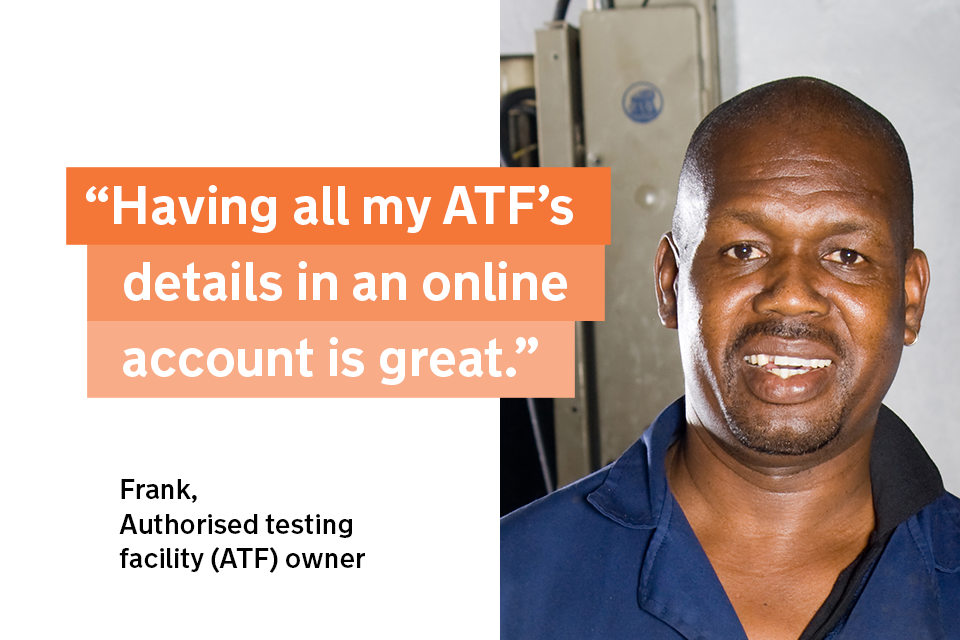
Frank, an ATF owner
Frank owns and runs a road haulage company, and has a rigorous maintenance schedule for his vehicles using his own mechanics.
Over time, the company started to take on maintenance and servicing for other companies in the area. Just over 4 years ago, Frank applied to become an ATF - a privately-owned test centre where DVSA vehicle standards assessors carry out lorry, bus, coach and trailer annual tests.
The application process involved lots of paperwork, and even now, it’s not as easy to manage his ATF as it is to manage his vehicle operator licence.
To help people like Frank, we will:
- make sure it’s easy to understand the end-to-end journey of setting up an ATF, what you need to do, and in what order
- create a digital service to apply to set up an ATF and let you track your application’s progress through to booking an appointment for DVSA to inspect your premises
- create a digital service to manage your ATF, including updating your business and contact details, managing test periods, finding information about your site’s performance and managing your financial account
- make it easy for you to give feedback about the service so we can be sure we’re making the right changes to improve it
- share information about what we’re doing to improve the service on our Moving On blog for the lorry, bus and coach industry and send you email alerts about these blog posts - this will help you know what’s changing and why
3.3 Protecting you from unsafe drivers and vehicles
Vehicle operator
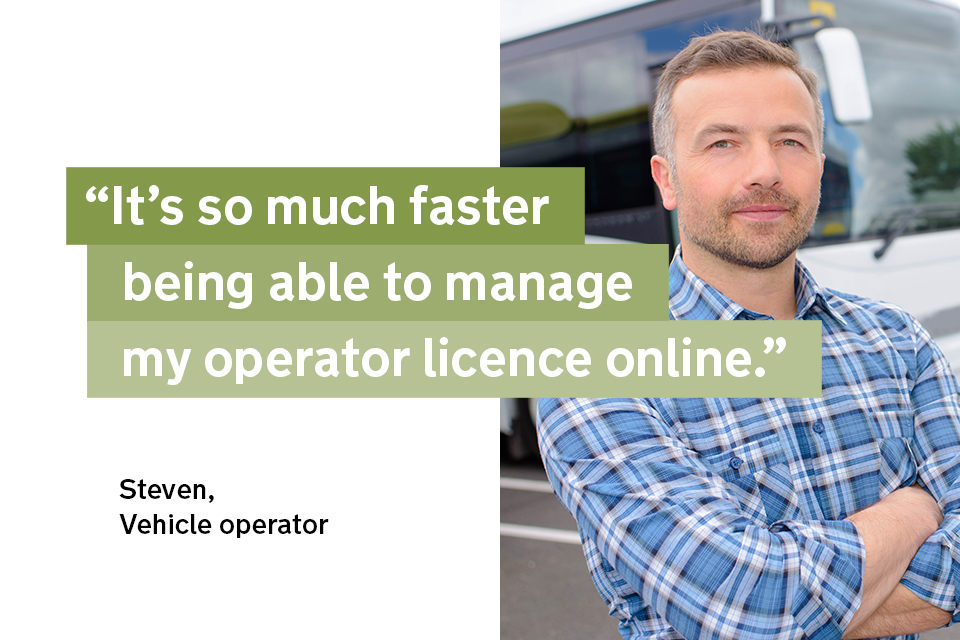
Steven, a coach operator
Steven is a director in a local company that provides coach holidays around Great Britain. He has a standard vehicle operator licence to do this.
The company has 30 coaches based at a single operating centre.
Recently, Steven and the company’s other director have been considering starting to provide coach holidays to some destinations in Europe, and need to know how the rules might change as a result of the UK’s exit from the EU.
To help people like Steven, we will:
- make sure it’s easy to understand the end-to-end journey of becoming a vehicle operator, what you need to do, and in what order
- continue improving the digital service to apply for a vehicle operator licence, keeping you informed about the progress of your application
- continue improving the digital service to manage your vehicle operator licence, so you can easily make changes to your licence, change the type of licence you have, and pay any associated fees conveniently and securely
- make sure DVSA traffic examiners have instant access to your operator licensing status, your vehicle test history and information about your drivers, so roadside checks are as quick as possible.
- create a digital service so you can apply to join the DVSA earned recognition for vehicle operators scheme, so you can prove you meet driver and vehicle standards by regularly sharing performance information with us - in return, your vehicles will be less likely to be stopped at the roadside
- improve the service for you to check your drivers’ Driver Certificate of Professional Competence (CPC) periodic training records
- make it easy for you to give feedback about the services you use, so we can be sure we’re making the right changes to improve them
- share information about what we’re doing to improve the services on our Moving On blog for the lorry, bus and coach industry and send you email alerts about these blog posts - this will help you know what’s changing and why
- share information about changes to laws, rules and policies that affect you as a vehicle operator using the Moving On blog, email alerts and social media
3.4 A great place to work
It’s important that our people have access to services that are easy to use.
Good internal services reduce training costs and the amount of time spent dealing with errors. This gives people more time to provide a good service to the public.
We’ll hold internal services for our people to the same standard we do a public-facing service.
We’ll work out the best way of meeting our peoples’ needs by getting a deep understanding of the tasks they’re trying to complete and the circumstances they’re working in.
This will help us achieve our vision of DVSA being a great place to work, where our people work in a positive culture and feel equipped and skilled to deliver the services we provide.
Driving examiner
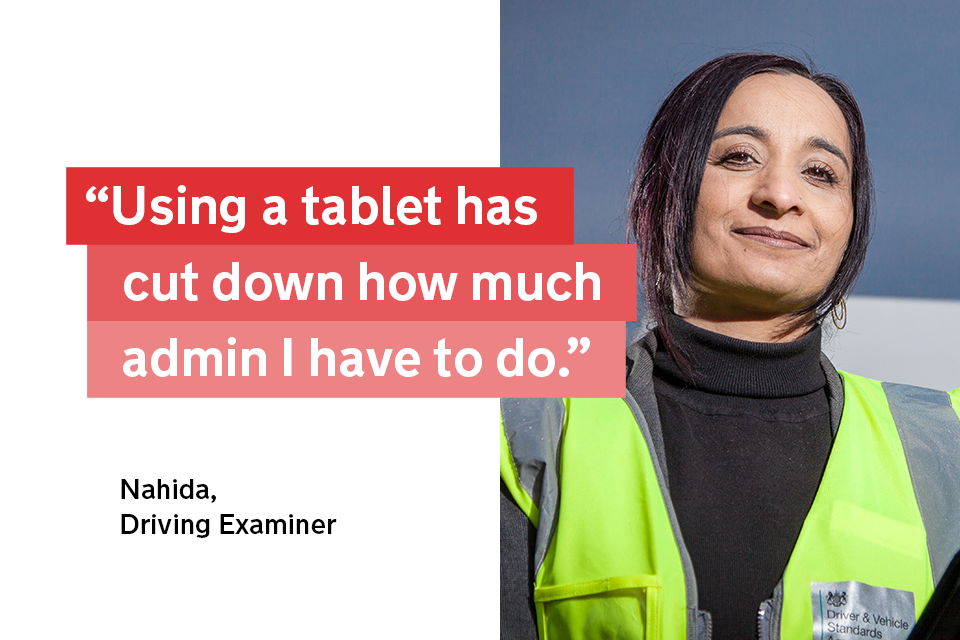
Nahida, Driving Examiner
Nahida is a driving examiner who usually works at Enfield driving test centre, but sometimes works at Chingford driving test centre.
She shares a PC in a driving test centre with other driving examiners. She needs to be able to access her emails and guidance, book leave and claim expenses, and see what other people in DVSA are working on.
She has to fill in a lot of paperwork about driving tests, and then post it to other teams in DVSA to make sure driving test results are recorded.
To help people like Nahida, we will:
- give you a tablet to access your email and calendar, book leave and claim expenses, look up guidance to do your job, and use work apps like Yammer to share what you’re doing and where you’re working, and watch videos that explain what DVSA is doing
- make it easy for you to stay in touch with your colleagues, for example, by using Skype video calls to talk to your local driving test manager if they’re at another site
- create an app to record driving test results and share them with relevant teams in DVSA and DVLA so drivers get their driving licence quickly - this will automatically load in the details of the candidate you’re assessing, cutting down the amount of admin work you need to do, and reducing the risk of errors happening
- make sure that you can connect to wifi easily within your office, and then stay connected to the driving test app while you’re carrying out driving tests
Vehicle standards assessor
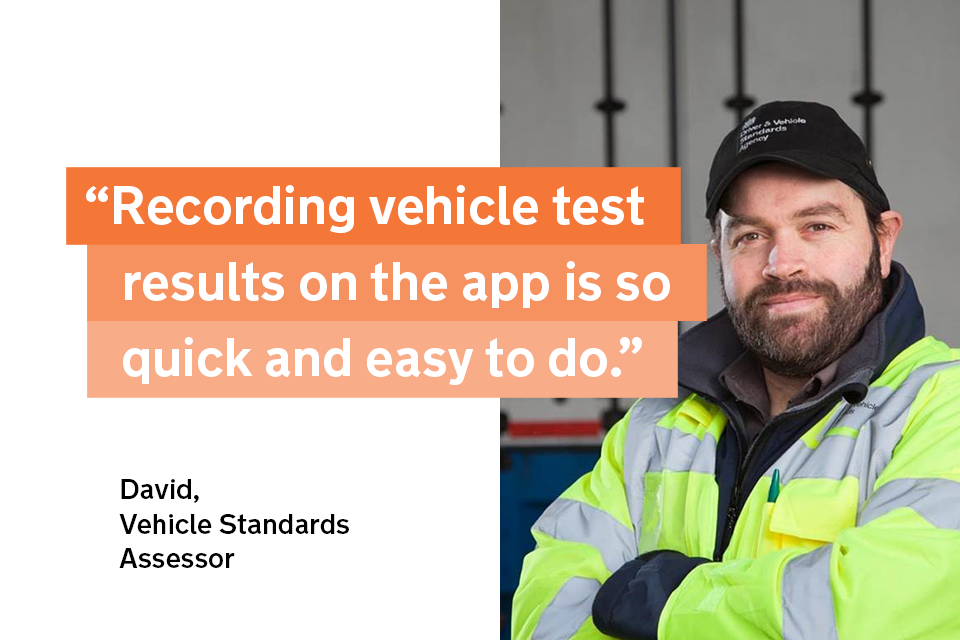
David, Vehicle Standards Assessor
David works as a VSA, and he’s a fully qualified mechanic. He visits authorised testing facility (ATF) operators’ premises to carry out annual standards assessments of their lorries, buses and trailers.
David is married with 3 school-age children, and his wife also works full-time.
The family owns a PC and 2 tablets, and David and his wife both use a smartphone. David’s is the latest smartphone, provided by DVSA. David and his wife use social media away from work - especially Facebook and WhatsApp.
To help people like David, we will:
- develop a smartphone app so you can record and communicate the results of lorry, bus, coach and trailer annual tests
- make sure you still test vehicles in an ‘offline’ mode when you’re at sites where the connectivity isn’t as good
- make sure you can access technical support and the most up-to-date information you need from your mobile device
- make sure you can see your up-to-date test schedule on the app, and can use it to schedule breaks into your day
- make it possible to report initial and emerging site problems when you visit an ATF via the app, so we can act swiftly to make sure you have a safe working environment
- help you connect with your team using email from your mobile device, and apps like Skype and Yammer to stay in touch with your managers and the wider VSA community
Traffic examiner

Sam, Traffic Examiner
Sam is a traffic examiner. It’s her job to protect road users from unsafe drivers and vehicles.
She spends most of her time out on the road, where she targets vehicles and drivers that don’t follow the rules about vehicle safety and drivers’ hours.
Sam is single and lives alone, but she has a very active social life and is also a scout leader. She has a PC at home and an iPhone that DVSA provided, but she’s allowed to use it for her own personal use.
To help people like Sam, we will:
- continue developing and improving an app to bring up a vehicle’s record by typing in its number plate or taking a photo of it - this will make it quick and easy to see the vehicle’s technical records, operator details, test and enforcement history and its operator compliance risk score (OCRS)
- make sure the app works on your smartphone or laptop
- make sure you can access technical support and the most up-to-date information you need from your mobile device
- help you connect with your team using email from your mobile device, and apps like Skype and Yammer to stay in touch with your managers and the wider enforcement community
- make sure you have a reliable work vehicle with wifi, a laptop dock, CCTV and solar panels, so you can travel safely and use the car as your own mobile office
Admin, professional and support staff
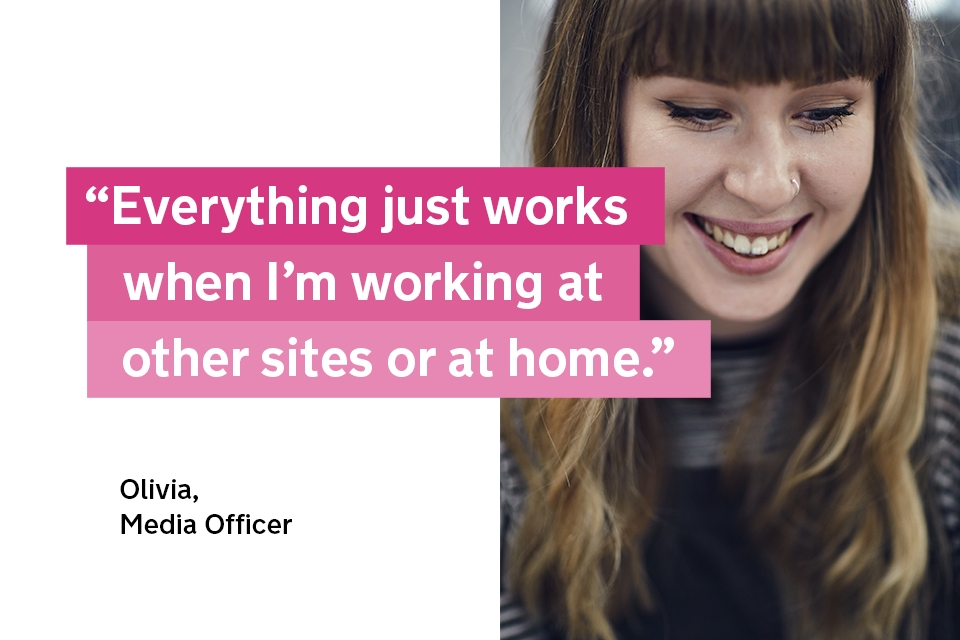
Olivia, DVSA Media Officer
Olivia is a media officer who works in DVSA’s External Communications team.
Olivia has to work all over the country, and needs to be able to access her emails, calendar and official information when she’s not in the office. Her team is also based at different sites around the country.
Olivia has to work from home when she’s providing out-of-hours cover for the press office. It’s just as important that she can access all the usual information she needs to do her job when she’s doing this.
To help people like Olivia, we will:
- make sure you have the IT you need to do your job, whether that’s in your usual office, working at a different office or working from home
- make sure that you can connect to wifi easily from anywhere in the office - whether it’s at your desk, in a meeting room, or in a quieter space for concentrated working - and that it’s just as easy to connect in other offices and government buildings
- give you a smartphone so you can make calls, access your email, calendar and documents and use work apps like Yammer to share what you’re working on
- make it easy to work on documents by storing them logically, making them easy to search, and then keep a track of the subjects you’re interested in
- make data available in more understandable ways, to help you make better decisions and answer questions more quickly - for example, running reports about the number of driving tests that have been carried out
- make it easy for you to stay in touch with your colleagues while reducing the amount of travelling you need to do, for example, by using Skype video calls with teams at other sites while working together on documents in real-time
4. What the strategy depends on
There are 6 areas which are essential for the strategy to be successful:
4.1 Our people

To successfully build and run digital services, our teams need to be multidisciplinary and have a range of skills.
Our teams must be able to work with teams from across DVSA and work with contractors or third parties.
It’s also important that our culture supports learning and development.
We need to do 3 main things to make this happen.
1. Recruit
We’ll recruit people with digital skills for the next generation.
Our aims are to:
- access new skills and experience from outside DVSA
- increase internal capability and capacity
- put succession planning in place
- recruit graduates and apprentices
2. Embed
We’ll work quickly to get the best from internal and external staff.
Our aims are to:
- establish teams and get them working quickly
- motivate people to deliver shared outcomes
- get suppliers genuinely comfortable working together as a single team, rather than competitively
- make knowledge transfer from suppliers a contractual obligation
3. Manage performance
We’ll build winning mixed teams that deliver fast and share ambition.
Our aims are to:
- have mixed teams acting as one to deliver project objectives
- manage the performance of suppliers to push delivery
- train and develop DVSA staff
Resourcing options
We’ll always try to have permanent staff working on our projects. We’ll consider hiring external staff when this isn’t possible because of pressures on our capacity or capability.
These options set out when we’ll use different approaches. Each depends on efficient recruitment, embedding and managing the performance of external staff, and making sure they work well with the permanent team.
| Option | What we’ll do | When we’ll use this option |
|---|---|---|
| Develop and grow internal staff | We’ll coach and develop internal staff and use apprenticeships, graduate recruitment and student placements. We’ll also focus on reskilling and upskilling our existing staff. | Ongoing staff management and development initiatives. |
| Temporary contract workers | We’ll manage and deliver the project, with temporary staff, hired as needed. | We’ll consider hiring contractors or consultancy support if there’s an immediate need that requires a ‘time and materials’ approach. This is where we agree to pay the contractor, based on the time they spend to do the work and the materials they use, no matter how much work is needed to do the job. |
| Managed service | We’ll work with an external supplier, who’ll lead the service to deliver it. | We’ll look for a supplier who can provide the required outcome competitively if a specific service is needed that can’t be delivered internally. |
| Partner | We’ll manage and deliver the project, with partner vendors engaged as needed. | We’ll look to strengthen our capability through a transfer of knowledge and skills from known vendors. This will be done under a framework agreement at pre-agreed rates |
4.2 Our principles

At DVSA, our digital, data and technology principles will help us to achieve the aims of our strategy. They’ll support significant change and create a more flexible and collective approach to how we do things.
These principles are designed to complement the:
- government design principles
- digital service standard (which will soon become the government service standard)
- Technology Code of Practice
1. Ensure business ownership
We’ll make sure everything we do has a business sponsor and a product owner in DVSA. With help from our strategy and architecture group, we’ll make sure new requirements and changes are met with the best reuse of our architecture.
2. Start with user needs
We’ll focus on the user and user journeys to simplify tasks, and provide intuitive services that they’ll choose to use. We’ll do this by capturing, analysing and managing user needs.
3. Focus on reuse
We’ll use common technology services, including cloud solutions, and build reusable components to reduce complexity and duplication.
4. Maximise data assets
We’ll deliver our front-line services effectively and improve road safety by accessing, sharing and analysing the data we hold.
5. Keep it simple
We’ll enable an intuitive user experience through fundamental service design.
6. Build for mobile
We’ll make our applications and services accessible for users, wherever they are and whatever device they’re using.
7. Make things open
We’ll use architecture standards to make it easy to transition and maintain components from multiple providers. We’ll use open data and application interfaces for flexible connections with industry, and to future-proof our technology.
8. Pursue cost efficiency
We’ll focus delivery on business requirements with a robust business case, and we’ll reuse components to reduce the need for new systems and configuration. This will allow us to deliver more projects at a lower cost.
9. Keep it secure
We’ll use a balanced approach to risk by designing in resilience and maintaining robust security. This will be proportionate to risk and compliant with government standards.
10. Minimise technical debt
We’ll understand technical debt, repay it, and manage it to provide reliable tools and services, both now and for the future.
4.3 Our processes
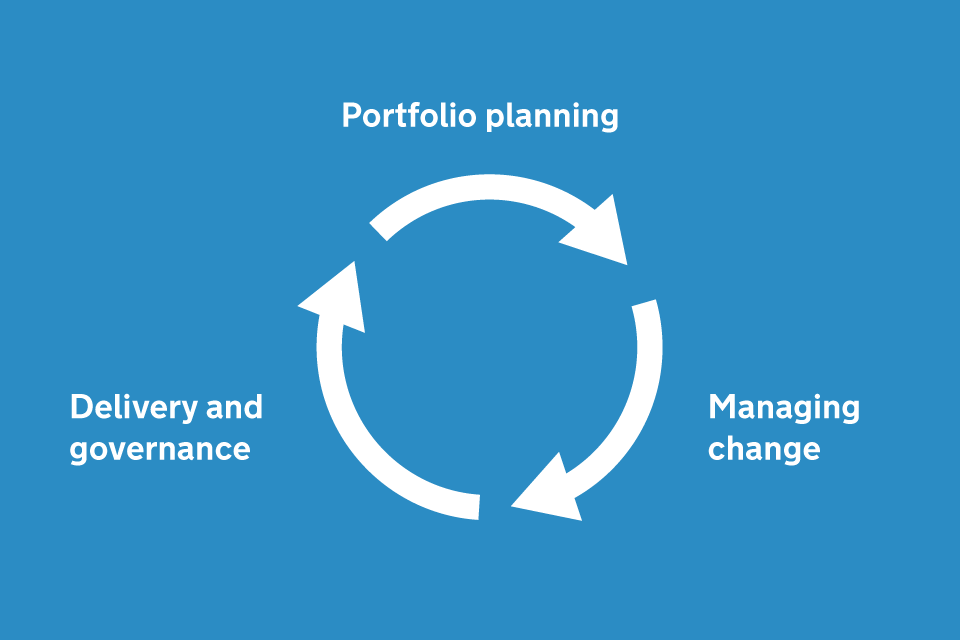
To achieve what we’ve set out in this strategy, we’ll prioritise business change projects. And we’ll take into account the capacity and capability we need to complete projects on time.
There are 3 process areas which will help us to do this.
1. DVSA portfolio planning
We will:
- help policy experts and operational teams early on when they’re creating business plans
- get a clear understanding of what changes need to happen to achieve the aims of DVSA’s 5 year strategy and our future operating model
- work with service management groups (groups of our staff who manage and improve our main services) through our business partners and our triage group (a group of staff who make sure new changes are properly assessed against capacity, strategy and business priorities)
- work with policy experts and operational teams to narrow down what changes we need to make, and make sure any changes fit with our strategic objectives
- hold regular short to medium term planning sessions to help prioritise our work, and we’ll build a plan based on these priorities
- recommend the best way of making things happen, taking into account priorities and the capacity and capability we need
2. Managing change at DVSA
To manage changes effectively, we will:
- work with the DVSA board to make sure our change portfolio matches our strategic priorities
- regularly assess our priorities, and manage things properly to make sure the right changes are made at the right time - we’ll put governance processes in place to help us do this
- build our portfolio, planning and governance function to manage project finances and risks effectively
- manage changes efficiently, using technology to plan and track resource, projects and programmes, and to manage risk and store documents
3. Flexible project delivery and governance
We’ll focus on working in an agile, flexible way. We’re moving away from large programmes that last for years, and towards smaller, quicker projects and contracts with staged releases (meaning that we’ll make small, regular improvements, rather than one big change). Working like this will mean quick benefits and real results.
We’re still learning how to adopt these practices and will continuously improve, based on what we learn.
To make sure we have good control of our work, we will:
- use agile governance with special project boards to introduce new services smoothly and more consistently
- include agile service design techniques, like understanding who the user is, what they need from the service, and making decisions on how to improve our performance based on data
- control our commercial spend by managing our suppliers and accurately scoping out work, so we don’t have to bring in unexpected extra resources
- get the best out of our information assurance measures based on business demands, rather than the limits of our IT
- plan across all stages of the software development lifecycle (a process we use to produce high-quality and low-cost software), considering design, what it will take to move people over to the new services or systems and then continuously improve
- create software in smaller blocks, so the work is done in a shorter time, meaning people get the benefits sooner
- improve our business analysis capability to help us develop better business cases, improve business processes and define what we need for new digital services
- provide effective change management and training, so changes to technology and processes allow us to get the maximum benefit and don’t have a negative effect on our users
4.4 Our technology
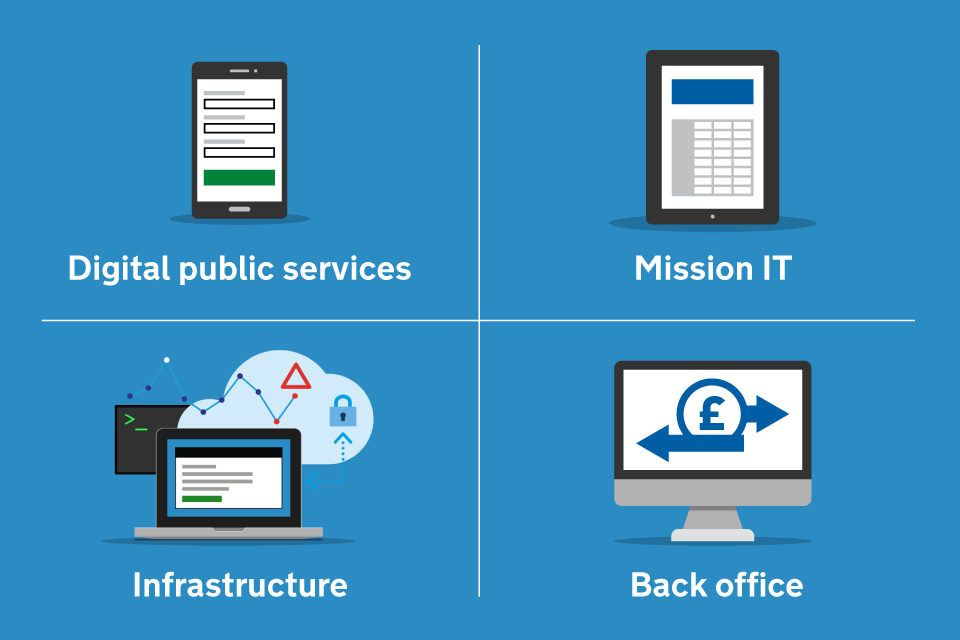
Choosing technology is one of the most significant areas of investment we’ll make when developing or maintaining our services.
Our choice of technologies has a huge impact on the quality of our services and our ability to operate and iterate them.
What we’ll consider when choosing technology
When choosing technology, the choices we make must allow us to:
- change our mind at a later stage
- adapt our technology as our understanding of how to meet user needs changes
We will:
- keep up to date with the latest technology developments so we can choose the best tools for our services
- minimise the total cost of ownership, including reducing the chance of getting locked in to long contracts for specific tools and providers
- use standard government technology components that are common across all services, like GOV.UK Verify, GOV.UK Notify and GOV.UK Pay
- use software that other departments have built, and make it easy to use software that we build
- make sure we always have full control of any data we store
Our technology in the future
We will evolve our legacy technology into a reusable component-based architecture. This means our digital services will be:
- supported by common applications
- built with reusable technology components
This will let us build and run great digital services for all our users, with a consistent user experience across multiple devices and locations.
We’ve grouped our technology vision for the future into 4 distinct functional areas.
1. Digital public services
These are the transactional services that people use to access our services. They include things like:
- booking and managing a theory test or driving test
- applying to be a driving instructor and managing your registration
- recording MOT test results or getting an MOT reminder
- applying for a vehicle operator licence and managing your licence
2. Mission IT
These are the line of business applications that run the internal processes of DVSA. They’re specific to our business functions. Many can be defined as ‘special’, although they draw upon underlying commodity components. They include things like:
- customer management systems
- workforce management tools
- document and content management
- knowledge management
3. Infrastructure
This is the common connectivity, hosting and device management services that enable us to have the tools we need in the hands of our people. It includes things like:
- storage
- backup and archives
- disaster recovery
- networking
- single sign-on for our staff
4. Back office
These are the day-to-day services like HR and finance that run the operations of DVSA. It includes things like:
- booking time off work
- viewing your payslip
- claiming expenses
- managing staff attendance
- buying goods and services
4.5 Our data
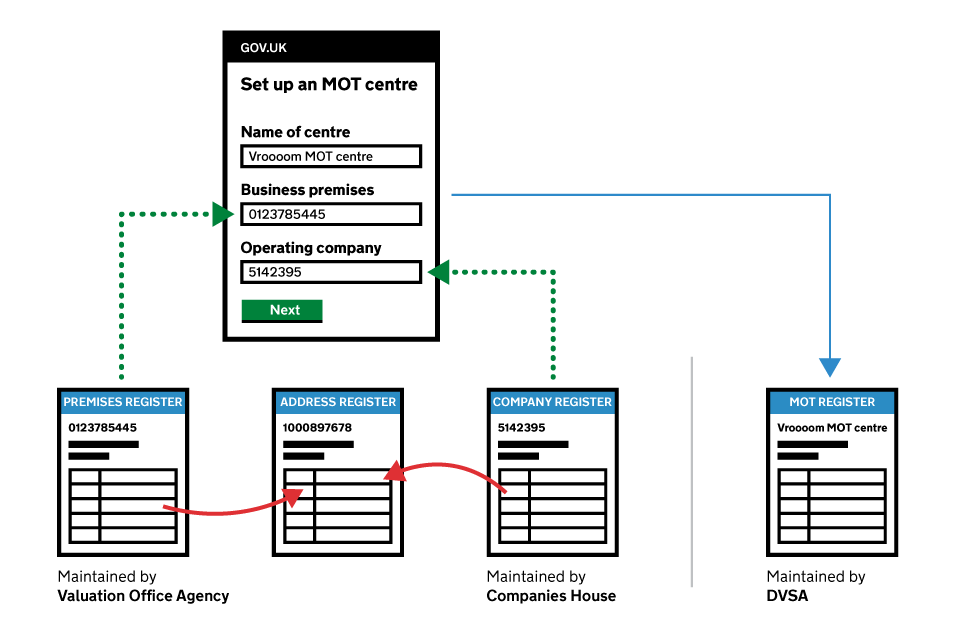
Data is a critical resource for enabling more efficient and effective services that respond to users’ needs.
DVSA holds datasets with a range of different characteristics. Some of this is unstructured, and some contains personal data relating to individual citizens. Other datasets contain information collated and curated by DVSA, such as lists of driving test centres and MOT centres.
DVSA must be more transparent about how we use data to develop policy and deliver services.
Trust
We must earn and keep the trust of citizens. And we must provide reassurance that personal and sensitive data is treated safely, securely and ethically within appropriate governance frameworks.
When we do share data, we must make sure that it’s appropriate and done in such a way to guarantee citizens’ privacy.
Creating a data strategy
We will create a separate DVSA data strategy which will set out how we can:
- drive business decisions
- better manage the full lifecycle of our data across DVSA from creation to archive
- move to ‘trusted versions of the truth’ for important datasets
- use data from other organisations and share data with them – using, where possible, government registers (lists of information, each of which is the most reliable list of its kind)
- protect our data and information assets and comply with regulations, such as the General Data Protection Regulation
- get maximum value from our data assets by using them to inform our strategy, planning and operational activities
4.6 Our commercial relationships

At DVSA, our vision is to create outstanding value through our commercial relationships. We want everything we buy to provide the best value for money.
We’ll continue to get better at engaging suppliers for digital, technology and delivery services.
We will:
- spend more time in talking to suppliers early in the tendering process, to make sure they understand what we need and whether they can provide it - this will help to maximise competition and encourage innovation
- spend less time on the procurement process by simplifying things wherever possible
- spend more time managing our contracts and suppliers, including managing their performance after we’ve awarded their contracts - we’ll do this using National Audit Office best practice and Government Commercial Function standards and guidance
We have 5 principles for digital procurement.
1. Focus on user needs
Our staff need the right tools to perform their roles effectively and efficiently, so we’ll always make this our priority when planning procurement and sourcing suppliers.
2. Ownership
DVSA can take ownership and control of our services, and the data within them, through effective management of supplier contracts.
3. Ease of transition
To allow for smoother transitions, our supplier contracts will explain our requirements and understanding of how a contract should end
4. Value for money
Everything we do must create outstanding value. That value will focus, not only on expenditure, but also on the benefit to users. We’ll be transparent about costs, to make savings while discouraging negative supplier behaviours.
5. Use government frameworks
We’ll use government procurement frameworks to source suppliers wherever possible. This will allow us to engage suppliers and use their services more quickly.
5. Supporting government policy

This strategy supports a number of government policies and strategies, and takes account of commitments made in them. They include:
- the government transformation strategy
- the motoring services strategy
- the Spending Review 2015
- DfT’s single departmental plan
- the UK digital strategy
5.1 Government transformation
This strategy supports the government transformation strategy, which sets out how the government will use digital to transform the relationship between the citizen and state.
The government transformation strategy’s vision is to put more power in the hands of citizens and be more responsive to their needs.
The tools, techniques, technology and approaches of the internet age give us greater opportunities than ever before to help government:
- better understand what citizens need
- assemble services more quickly and at lower cost
- continuously improve services, based on data and evidence
Supporting the strategy’s objectives
This strategy will support the government transformation strategy’s objectives to:
- continue to deliver world-class digital services and transform the way government operates, from front end to back office, in a modern and efficient way
- develop the right skills and culture among our people and leaders, and bring together policy and delivery to enable services to be delivered in a learning and iterative environment, focused on outcomes for citizens
- build better workplace tools and processes to make it easier for public servants to work effectively, including sourcing, governance, workplace IT, businesses cases, human resources processes, common technology across the public sector and better digital tools for civil servants
- make better use of data - not just for transparency, but to enable transformation across government and the private sector
- create, operate, iterate and embed good use of shared platforms and reusable business capabilities to speed up transformation - including shared patterns, components and establishing open standards
5.2 British road safety statement
The government has a commitment to reduce the number of cyclists and other road users killed or injured on our roads every year.
The government’s road safety statement sets out the approach to improving road safety. It includes actions on issues such as:
- safer road users
- safer vehicles
- road safety management
DVSA’s strategy for 2017 to 2022 directly support these issues, and our digital, data and technology infrastructure is essential for that strategy to be successful.
5.4 Motoring services strategy
The government’s motoring services strategy sets out the goal of making DVSA more responsive, more flexible, with services delivered in ways that better meet users’ needs.
As part of that strategy, we’ve committed to things such as:
- working with DVLA to streamline the large goods vehicle driver licensing process
- improving our relationship with driving instructors, working towards publishing more information about them to improve the choice for learner drivers
DVSA’s strategy for 2017 to 2022 takes account of these commitments, and our digital, data and technology infrastructure is essential for that strategy to be successful.
5.5 Spending Review 2015
The Spending Review gave a view of the government’s spending plans from 2016 to 2020. It looks at the budgets of all the government departments.
They’re divided into:
- resource spending - which covers the cost of policies, programmes and administration
- capital spend on assets like buildings and roads
As an executive agency of DfT, we’re expected to deliver both a dividend and capital receipts from the sale of assets.
DVSA’s strategy for 2017 to 2022 includes measures to help us become more efficient, and our digital, data and technology infrastructure will help us with those measures.
5.6 DfT’s single departmental plan
DVSA’s strategy for 2017 to 2022 supports DfT’s single departmental plan, which describes DfT’s objectives. Our digital, data and technology infrastructure is essential for that strategy to be successful.
5.7 UK digital strategy
DVSA’s digital, data and technology strategy supports the UK digital strategy, which sets out how we’ll build on our success to date to develop a world-leading digital economy that works for everyone.
